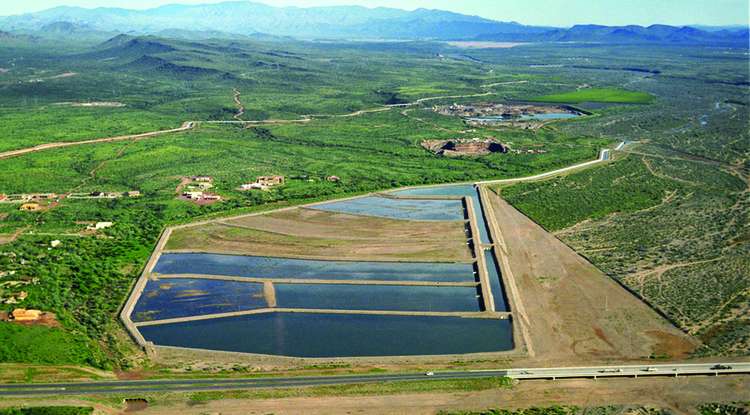Agua Fria recharge basins in Phoenix. Credit: University of Arizona
In the heat of June, before the monsoon arrives, thoughts turn to water and how we manage to live in a desert. In central Arizona, we know that much of the water comes from the Colorado River via the Central Arizona Project, or CAP, and we know that basinwide drought and overallocation are threatening that supply.
But what do we know about how Arizona has been working for years to meet the challenge of water shortage? A new publication by the University of Arizona's Water Resources Research Center reports that water storage underground in recharge projects—Arizona's water banking—has built a buffer against shortages that may occur in the future.
"Arizona Water Banking, Recharge and Recovery" is the latest in the WRRC's Arroyo series of publications that each year tackles an important water topic. The Arroyo provides the general reader an easy to access state-of-knowledge summary. Original research for the 2017 Arroyo was performed by the winner of the WRRC Summer Writing Internship, Noah Silber-Coats, a doctoral student in the UA School of Geography and Development. The draft received extensive review by water resources professionals to ensure accuracy.
Since 1986, when the Legislature established the Underground Water Storage and Recovery Program; 1994, when the Underground Water Storage, Savings and Replenishment Act was enacted to refine the program; and 1996, when the Arizona Water Banking Authority, or AWBA, was established, the role of underground water storage has become a major water management strategy. The AWBA has stored more than 4 million acre-feet of water and other entities, including the city of Tucson, have stored additional millions of acre-feet. (An acre-foot equals 325,851 gallons, or enough water to supply three average Tucson households for a year.)
Currently, water savings and storage facilities have a total permitted capacity of almost 2.1 million acre-feet per year. Although not all of this capacity is used, both CAP water and reclaimed water are adding substantially to our water banking accounts. Groundwater levels are stabilizing or rising near these facilities. Long Term Storage Credits that represent this water stored a year or more are bought and sold. Communities are coming up with creative ideas that use water banking to meet their responsibilities for water reliability.
Beyond the simple concept of storing water underground in natural aquifers for future use, water banking in Arizona deals with a series of questions such as how and where the water is stored, who owns the stored water, how much can be legally recovered, and when and where can it be recovered. Answers to these questions make water banking, recharge and recovery very complex. Administered by the Arizona Department of Water Resources, or ADWR, these activities create great flexibility within a stable framework. They provide the means for achieving multiple goals simultaneously, including saving for the future, reducing groundwater depletion, conserving potable supplies and facilitating exchanges that save water and money.
Yet unresolved issues remain, particularly regarding how recovery will take place. A Joint Recovery Plan, worked out by CAP, ADWR and AWBA with input from the U.S. Bureau of Reclamation and other stakeholders, has established the foundation for recovery, but more discussion is needed to be sure that when the stored water is needed, its recovery occurs fairly and efficiently.
Arizona's water banking, recharge and recovery are not well understood by the general public, their representatives and many of the people who will feel the impact of management decisions. The WRRC publication seeks to clearly and succinctly reduce the complexities of the subject.
"Arizona has its own form of water banking, unlike California or other states, and people here need to know what it does for them and how it works," said Susanna Eden, one of the study authors and assistant director of the WRRC. "Water security depends on an informed citizenry."
More information: The 2017 Arroyo is available free for download at wrrc.arizona.edu/publications/ … echarge-and-recovery
WRRC publications: wrrc.arizona.edu/publications
Provided by University of Arizona






















